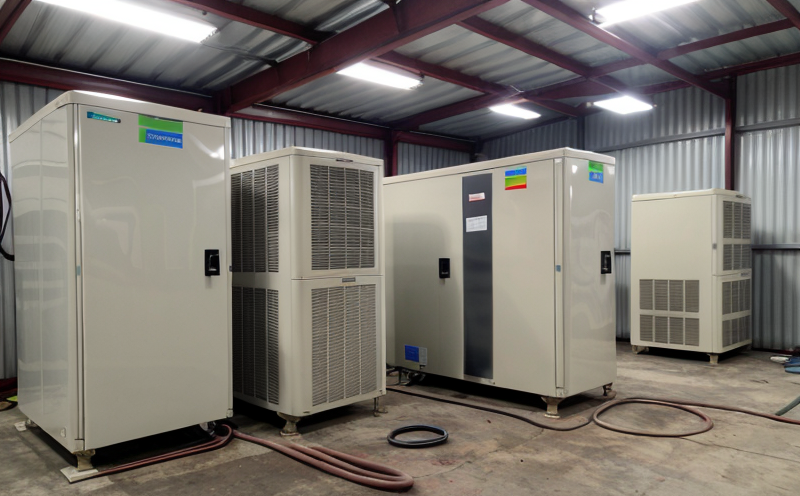ISO 14276-2 Halogenated Refrigerant Leak Detection
The ISO 14276-2 standard provides a method to detect leaks of halogenated refrigerants in HVAC equipment. This testing is critical for ensuring the integrity and efficiency of refrigeration systems, as even small leaks can lead to significant operational inefficiencies and potential safety hazards.
Halogenated refrigerants such as R-123, R-22, R-410A, and others are commonly used in HVAC applications. These refrigerants are known for their high efficiency but also pose challenges when it comes to leak detection due to their chemical properties. The standard outlines specific procedures to identify leaks accurately without damaging the system.
The testing process involves placing a halogenated tracer gas (such as isobutane) into the refrigerant circuit and then using specialized equipment to detect any trace amounts of this tracer. This allows technicians to pinpoint the exact location of the leak, enabling timely repairs before further degradation occurs.
Accurate and reliable leak detection not only enhances system performance but also contributes significantly to environmental sustainability by preventing the release of potent greenhouse gases into the atmosphere. The use of this method ensures compliance with regulatory requirements while promoting best practices in HVAC maintenance.
The ISO 14276-2 protocol is particularly useful for verifying the tightness of newly installed systems, maintaining existing equipment, and conducting periodic inspections to ensure ongoing performance standards are met. For quality managers, compliance officers, R&D engineers, and procurement professionals involved in HVAC projects, this testing ensures that all components meet stringent international standards.
By employing advanced leak detection techniques like those specified in ISO 14276-2, organizations can enhance their reputation for reliability and sustainability, thereby fostering trust among customers and stakeholders. This approach also helps in reducing operational costs associated with frequent repairs and replacements due to undetected leaks.
| Step | Action |
|---|---|
| 1 | Prepare the system for testing by isolating it from other components. |
| 2 | Introduce a halogenated tracer gas into the refrigerant circuit. |
| 3 | Use specialized equipment to monitor for any presence of the tracer gas outside the intended circuit. |
| 4 | Identify and document all detected leaks, specifying their locations within the system. |
This systematic approach ensures that every aspect of the refrigerant handling process is scrutinized thoroughly. It allows for proactive identification of potential issues early on, which can prevent costly downtime and premature equipment failure.
For organizations operating in sectors where regulatory compliance is paramount, such as commercial buildings, industrial facilities, or public transit systems, ensuring adherence to standards like ISO 14276-2 is essential. This not only meets legal requirements but also demonstrates a commitment to excellence that can lead to long-term benefits.
The precision offered by ISO 14276-2 testing methods makes it an indispensable tool in the maintenance and operation of HVAC equipment. By leveraging these techniques, businesses can maintain optimal operating conditions, extend equipment lifespan, and contribute positively towards environmental conservation efforts.
Why It Matters
The importance of leak detection cannot be overstated when dealing with halogenated refrigerants in HVAC systems. These refrigerants are integral to the efficient functioning of air conditioning units, chillers, and other cooling equipment. However, leaks can have severe consequences if left unchecked:
Increased energy consumption: Leaks result in the escape of refrigerant gas, reducing the system's ability to absorb heat effectively.
Potential safety hazards: Halogenated refrigerants are flammable and toxic under certain conditions, making their leakage a risk factor.
Environmental impact: The release of these potent greenhouse gases into the atmosphere contributes significantly to global warming.
By implementing ISO 14276-2 leak detection procedures, organizations can mitigate these risks and ensure compliance with relevant regulations. This proactive approach helps protect both people and the planet while maintaining operational efficiency.
In addition to avoiding penalties associated with non-compliance, businesses that adhere to rigorous testing protocols like ISO 14276-2 also benefit from improved brand reputation and customer satisfaction. Satisfied clients are more likely to recommend services or products to others, fostering growth and loyalty within the market.
Applied Standards
| Standard | Description |
|---|---|
| ISO 14276-2:2015 | This part of ISO 14276 specifies the procedures for halogenated refrigerant leak detection using isobutane as a tracer gas. |
| ASTM E394-18 | American Society for Testing and Materials standard that provides guidelines for testing methods used in determining leaks in refrigeration systems. |
The application of these standards ensures uniformity across different industries, facilitating interoperability between various manufacturers and service providers. Compliance with such internationally recognized protocols underscores the commitment to quality and reliability in HVAC equipment maintenance practices.
Moreover, adherence to these standards can help organizations gain a competitive edge by demonstrating their ability to meet high standards of performance and safety. This is particularly valuable for those operating under stringent regulatory environments or seeking certification from reputable bodies.
Eurolab Advantages
At Eurolab, we bring extensive experience in HVAC equipment testing to every project involving ISO 14276-2 leak detection. Our team of experts ensures that each step of the process adheres strictly to international standards, providing accurate and reliable results.
Precision: We utilize state-of-the-art instrumentation capable of detecting extremely low levels of leaks, ensuring minimal false positives or negatives.
Expertise: Our technicians are trained specifically in halogenated refrigerant handling and leak detection techniques.
Compliance: All tests conducted meet the stringent requirements set forth by ISO 14276-2, guaranteeing compliance with applicable regulations.
In addition to these technical advantages, Eurolab offers comprehensive support services throughout the testing process. From initial consultation through final reporting, our goal is to provide seamless service that meets your unique needs and expectations.
Our commitment to excellence extends beyond just meeting standards; it includes providing valuable insights into areas where improvements can be made based on test findings. This proactive approach ensures continuous improvement in system performance and longevity.





